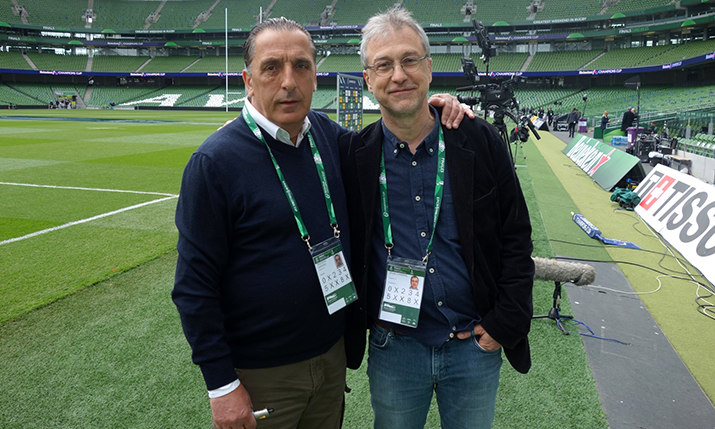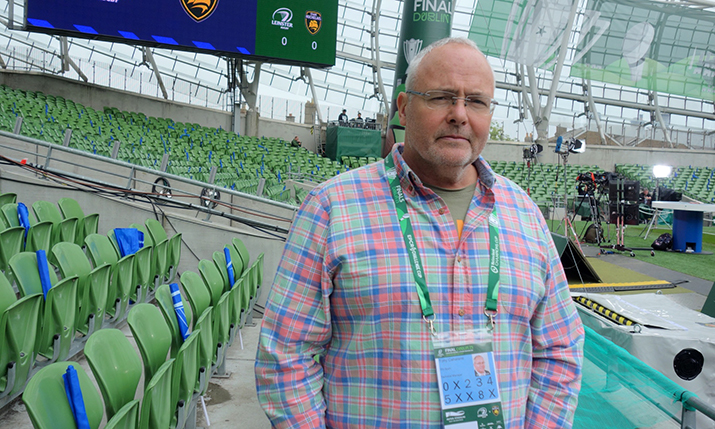Live from Dublin: Free-to-air with France Télévisions and ITV Sport

France TV match director Frederic Godard (left) and production manager Olivier Chabrol
France Télévisions is a major partner of rugby in France across the EPCR competitions and the Six Nations, with close to 48 million viewers watching rugby on the network last season in a Grand Slam year for the French team. In the current EPCR rights deal, the free-to-air broadcaster has committed to screening two top Heineken Champions Cup fixtures on France 2 and one EPCR Challenge Cup match on France 3 each weekend.
“This is a big event for us. We’ve been broadcasting the European Cups since the very beginning in 1995 and we have always had the rights,” Olivier Chabrol, production manager, France Télévisions, told SVG Europe in Dublin.
“Rugby is very important for France Télévisions because as you know we have the Six Nations, and we would put the EPCR finals at the same level of importance as the Six Nations. We are very proud to be involved with this competition, and the history of the EPCR and before that ERC is linked with our own history.”
“It brings very big ratings,” added match director Frederic Godard. “Maybe France v England in the Six Nations would do better. But we don’t see any difference between them – certainly when there is a French team involved.
“It is very important for us to have a French team in the final. It does make a big difference. And today, of course, the two teams are so big, we just don’t know who will win.”
“Here we have a studio presentation with a presenter and a rugby analyst, Vincent Clerc, and a commentator here in the stadium. In addition we have six unilateral cameras: a big lens camera, reverse pitch-side, three cameras for the pitch-side studio and one camera in the gantry at the commentary position.”
“The storytelling is similar to the Six Nations, the difference being on Six Nations match-day we have two games so in between games we have a longer studio show which makes it slightly different,” said Chabrol.
“Here we are working with NEP who provide the OB truck but we have brought three camera operators from France, with whom we work all year round, an EVS operator and sound crew as well. With sound, it’s obviously necessary to have someone who speaks French so we bring our own people – and the rest of the technicians are from Alan Burns’ NEP team.
“It is very important for us to have a French team in the final,” said Godard. “It does make a big difference. And today, of course, the two teams are so big, we just don’t know who will win. This is a big match for us today.
“We have been lucky that most of the time during the years there has been a French team in the finals. And we are approaching the Rugby World Cup as well, so this is a big part of our build-up to that tournament. But today, the winner is rugby!”

ITV Sport technical director Tony Cahalane: “There is more and more broadcaster interest to be on-site again post-Covid”
ITV looks to hold rugby audience ahead of Rugby World Cup
“Having done lots of UEFA Champions League Finals, I see this weekend as a blossoming version of that,” ITV Sport technical director Tony Cahalane told SVG Europe. “There is more and more broadcaster interest to be on-site again post-Covid, which is great in bringing the community together and gives us an opportunity to talk about this season and about the upcoming season as well. But as an occasion, it’s very much the pinnacle of the rugby season.
“During the season we host some matches and do pres add-ons for various others. For this one we’re the latter but we bring a reasonably sized team. For the Champions Cup Final tonight we’ll take the world feed and quite a number of iso feeds from the host and generate our own pres with a pitch-side approach.
“We don’t go into a studio: more and more we’re on-site to gather the atmosphere, which is a current trend in television,” said Cahalane. “Pitch-based, with our own mobile reporter, commentary on-site, our own big lens up in the gantry to tell the story a little bit from our editorial view. So we’re here in a reasonable way.
“Obviously we feed into EPCR throughout the season and hope that collectively, as a group of broadcasters, we drive that innovation which then comes to us all via the world feed this weekend. All of the broadcasters involved in the coverage are familiar, friendly faces. Thankfully, post-Brexit, we still mix very well across Europe! And EPCR handle it very well in terms of keeping those relationships oiled and close.
“This industry is very people-driven and relationship-driven, and that’s how we get things done. With rights deals and deadlines so late in the day now, we’re very much reliant on those relationships.”
How big is this match for ITV Sport and its audience? What kind of audience would you expect? “Well, we’re in the process of building up to the Rugby World Cup, for which ITV is the exclusive UK broadcaster. So this is a big one for us … and we’ve just finished the Six Nations as well, which we have the majority of nowadays in the UK. We have France, Italy, England and Ireland: they’re all our Six Nations matches in the UK. So with tonight’s game as well, we’re hoping to keep that audience on-board for the start of the Rugby World Cup. We’re very much deep in the technical planning of that at the moment,” said Cahalane.
“We are maximising what we can do in terms of minimising our carbon footprint, while at the same time still giving the viewer at home the best we can.”
Any teasers as to what ITV could be looking at for Rugby World Cup coverage? “Well like any broadcaster nowadays we’re having to look at things from a different perspective, as to how we can achieve things in a more green way. We’ve recently launched a VR studio which is a sport hub to give us opportunities to be able to do some of the things we do like La Liga and motorsport where we can host it from a fixed position.
“For the Rugby World Cup, in order to minimise the amount of people travelling but still gaining the best atmosphere, we’ll have three levels of different types of facilities on-site.
We’ve got venue injects, which are simple reporter team set-ups with the programme hosted during the group stages in the hub back in the UK. Then we’ve got remote production units, which give us the same sort of thing as we’re doing here, with presentation position pitch-side and a big lens up on the gantry which is something we’ve expanded from our Six Nations coverage abroad recently.
“But once we get to the knockout stages we appear on-site, very much like we are today, where we want to get closer to the atmosphere and to the presentation team and the producers, directors and programme editors. Because that’s how they feed off each other: they sit the night before and talk, and it’s not just a Zoom meeting. We’re really trying to encourage that creative element.
“So we’ve got those three levels of facilities. But we are maximising what we can do in terms of minimising our carbon footprint, while at the same time still giving the viewer at home the best we can.”
Read more:
- Live from Dublin: Broadcasters work together to deliver Challenge Cup and Heineken Champions Cup finals
- Live from Dublin: RTÉ Sport team hosts Champions Cup final broadcast coverage
- Live from Dublin: Sunset+Vine takes on Challenge Cup final for BT Sport
